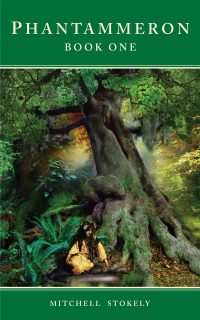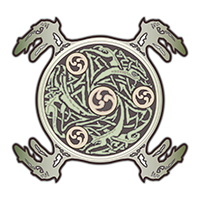The Sorcerer’s Apprentice is an ancient story that has appeared recently in modern literature and music. To me, it embodies some of the most crucial aspects of Indo-European tradition and culture. The Sorcerer’s Apprentice is in fact, from my research, a very old relic of our ancestors involvement with sympathetic magic and the path of the shaman initiate in mastering the powers of tribal pagan religion. The idea of an apprentice wizard who tries to command powerful magic without the skill and experience to do so, is an ageless theme. But more than this, it touches on something much deeper than the modern moral theme of the inexperienced youth.
Most of us have been exposed to the wonderful animated Disney film, Fantasia (1940 – conductor, Leopold Stokowski). It is a master-work of animation and music, and incorporates the beautiful musical work of French Composer, Paul Abraham Dukas’s (Sorceror’s Apprentice , 1897). In the original scene, Disney’s Micky Mouse is left to do his his master’s chores. Instead, he uses the wizard’s spell book to enchant a broom. He then commands the broom to do his work, carrying water up to the castle. He falls asleep and finds the castle flooded. So he gets an axe and kills the broom, but finds it has multiplied. It them continues to fill the castle with water and Mickey soon finds he cannot stop it. The old Wizard returns and castes a spell that returns the castle back to its normal state. He then punishes Mickey for his mistake. The story ends with a very moralistic note; that the apprentice would be wise not to use powers which they do not have the knowledge and experience to master.
This was my first exposure to Disney as a child, to Paul Dukas’s music, and the story of The Sorcerer’s Apprentice. The story is such that it is very easy for children to understand and it has a very definite impact on you. It is one of those scenes in Fantasia you never forget. The animation in combination with the music is brilliantly done, and has turned out to be one of the more memorable childhood animation sequences of the 20th century. That film and that scene has stuck with me for many many years. But the story has haunted me for much longer.
Paul Dukas’s original Sorcerer’s Apprentice score above…
It turns out, that the real success and power behind this animation stands on the amazing musical score of Paul Dukas (in my opinion). Over the years I have divorced myself from the Disney theme/animation and listened to the music by itself. (If you take the time and explore the music and listen to all the layers of it, you begin to form an even richer imaginary world; one where you imagine a much darker and more meaningful story behind the music). Of course we all have different interpretations of music. But the power of the music led me to believe Dukas had in fact seen something deeper in this story. That led me on to find the true source of the story, which it turns out, was a poem of a much earlier author.
It turns out that both the animation, the music, and the story all originate from a famous 18th century writer and poet, Johann Wolfgang von Goethe. Goethe wrote The Sorcerer’s Apprentice (Der Zauberlehrling – 1797) almost exactly 100 years prior to Dukas’s romantic score. Goethe, in fact, was a student of Greek and Latin philology and had taken his apprentice tale from the Greek author Lucian, written c. AD 150. That, at least, is the current “theory”. So, the story from Goethe likely originated from a mockery tale from a Roman author written almost 1600 years previous. After reading these versions of the story I began to get a better understanding of the story. I then decided to draw my own version of the sorcerer’s apprentice tale. It wasn’t anything fancy….just a series of pen and ink drawings showing a young wizard summoning up evil spirits from the underworld in a dark cavern in the underworld. The original story appears to show that the powers of the broom originate from some sort of underworld spirit or demonic powers controlled by the master shaman. So, I felt I had given the story my own interpretation and left it at that. But, the more I thought about this tale, the more it started to take on an even deeper and darker meaning.
Without delving into the various forms of the story behind the sorcerer’s apprentice, it soon became clear to me that this story – in all its variations and versions – had originally contained some hidden meaning; some “Western cultural theme”. When I began to compare other tales of young men in Western mythology and story, who were driven to perform acts under an older shaman, druid, or warrior, it became clear that this story was in fact a relic of Indo-European “shamanic initiatory rites”. In other words, the story was likely used as part of initiation of young men, and women, into the ancient shamanic inner circle. It was in fact, an important emotional tool in relaying not only the supreme power of the druid or shaman in controlling say, the power of life and death, of the bringing of the seasons, of his power over the sun and moon, but more importantly a tool for securing the initiates eternal loyalty towards learning and passing down the ancient teachings of the tribal shaman.
When you compare this apprentice tale with similar stories from Western mythology – like that found in the Norse Prose Eddas or the Fisher King tale, where in the former the importance of shamanic poetic integrity is important, or as in the latter tale where the relationship of an older king to a younger warrior is critical to the fulfillment of the story – you find the central theme of the importance of the connection of the druid or shaman of the tribe with the younger generation of chosen shaman initiates. We know from other history, that Druidic culture in Briton was destroyed when the Romans moved in and cut down their sacred groves and polluted their sacred springs. Instead of killing these ancient pagan cultures, however, they simply delayed their demise, simply because the main source of these ancient religions resided in the poetry, ballads, and stories passed on by the shamans to their initiates.
In fact, Goethe’s Sorcerer’s Apprentice ballad is much more than a moral tale against young people trying to be good at a craft before they are ready and fully trained by an experienced leader. In truth, this story is about the power of our ancient Indo-European ancestors in using story-telling to preserve and pass on powerful pagan traditions and culture maintained in the tribe. This story was both a tool used by the shamanic order to teach new initiates, but a form of magic spell encased in story-telling used to convey the power of the shaman to his people. It was in a sense one way the shaman perpetuated the practice of pagan religions all over Eurasia. Being retold over and over, it also conveyed the shaman or wizard of the tribe as being one of the “central archetypes” bred into the subconscious of all Indo-European cultures; that the wizard of the tribe controlled the elements, controlled the sun, controlled the seasons, and controlled the birth of children and of the animals and plants and all things in the earth and sky. The Shaman’s powers to convey not just his power, but the “meaning of life and living” in this world to each person in the tribe via story-telling, was critical to the survival and motivations behind Western culture and its peoples. Most importantly, as the mythology of this wizard archetype was transferred from generation to generation over thousands of years in the tribe, so was the wizard archetype evolved and inculcated into the mind, the DNA, the subconscious, and culture of all Indo-Europeans. (The archetype is something Joseph Campbell has touched on). Without the continual reminder of the power of the shaman over not just the initiate, but of the tribe, it would have been lost forever in one generation! Therefore, it appears that this story likely was a part of a much bigger repertoire of tales used to fascinate, initiate, and inculcate everyone in the tribe. Powerful stuff, if you think about it!
To carry on his tradition, certain stories had to be passed on by the shaman to the initiates. His “spells” and magic power over nature and the world as sympathetic magic, had to be respected and given to the initiate exactly as it was passed on to him. Before the age of writing, this process had to be done verbally. Knowing all this, it makes sense that a central story relating a warning to those that fail to follow the shaman or wizard of the tribe, makes sense. It also makes sense that by the time of the Roman’s Lucian’s tale of mockery of superstitions and of the shaman and his power over the underworld and make-believe would have been reflected in his own writing at the time of massive Roman expansion into Gaul , Briton, and Germania where these old practices were still going on. But the oral tradition of the shaman and the druid continued well into our century. We have faery tales (Grimm) and Scottish poems and Nordic eddas. And we have modern writers exploring these stories again today.
The reason The Sorcerer’s Apprentice affected me, as it has affected so many children, is simply because the archetype of the “wise old wizard”, the Saint Nicholas, the Merlin wizard, Gandalf, and others, is a part of our brains….its bred into our chemistry and DNA. Its an archetype lodged into our subconscious children of Western culture cannot escape. The power of the initiate under an elder shaman is a reflection of the ancient culture of our ancestors, and a critical part of the success of Western culture around the world. The motivations, innovation, imagination of Western thought originates from thousands of years of thought processes, beliefs, goals, and traditions….all of which served a purpose of survival and success in our environment. Whether we today believe that a shaman or wizard controlled the movement of the sun or the travels of a dead spirit successfully through the underworld does not matter. But the subconscious connection to that belief and the ancient symbols in our imagination does matter.
Knowing that the original purpose of the apprentice tale was to teach young shaman initiates to first learn the shaman’s spells, stories, and their meaning so that the tribe could continue to thrive, reminds us that this story likely was indeed one of the reasons why the shamanic pagan culture in Western Asia survived for thousands of years. The fact that we as children in a modern Western society still respond to the “wizard’s tale” in all its colorful forms – in ancient literature, mythology, poetry, children’s literature, modern adult fiction, and even modern religious traditions – tells us it is in fact a part of our DNA. The ancient story behind the Sorcerer’s Apprentice sustains us even today, and is an important reminder of our shared Indo-European cultural identity; holding up the Light of Truth in the tangled cobwebs of our subconscious minds, to light a way towards some hidden meaning, power, or purpose in our lives, which strangely, only the ancient wizard knew, and still knows.
– The Author



